Tires are easily the most underrated safety feature of any vehicle. For the average passenger vehicle, the contact patch (the part of the tread that actually contacts the road) is roughly about the size of your open hand. Those four relatively tiny contact patches bear a lot of responsibility. They provide the entire grip required to stop, steer and accelerate your vehicle.
Most motorists neglect their tires and fail to realize the significant role they play in motoring safety. The most common fault is not ensuring tires are properly inflated. Many motorists will shop for a less expensive alternative to their OEM tires, sacrificing handling qualities for a few dollars. Too many drivers will settle for the compromise of an “all season” tire for winter driving. On the other hand, a few auto enthusiasts will actually upgrade their tires to obtain improved handling characteristics and safety.
The bottom line is we should never take our tires for granted. Along with keeping them properly inflated, they should be frequently inspected for irregular wear patterns, punctures and tread life.
More: Tires constantly leaking? It might not be the tires
More: Are 'all-weather' tires the best for GTA driving?
There is also another very important, but less obvious feature of your tires you should be paying heed to, their age.
Tire rubber compounds are subject to degradation as they age. Exposure to ozone and ultraviolet light will harden and dry the rubber making it brittle. Signs of aging can be seen on the tire tread and side wall in the likes of small cracks in the rubber. This is a visual warning to you that any tire with cracks showing in the side wall or tread has reached the end of its service life and needs to be replaced.
Three significant problems arise with this aging.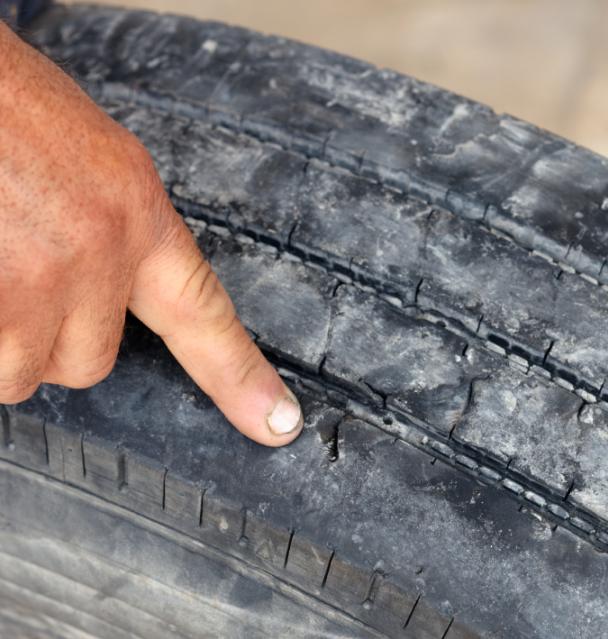 One, the tire rubber has hardened to the point where the level of grip is compromised. This will lengthen braking distances and reduce handling quality. Two, the rubber will become more porous allowing air to leak out quicker increasing the chances of the tire developing dangerously low tire pressures. Three, with the aging of the rubber compounds, the tire stands a greater risk of delaminating or coming apart.
One, the tire rubber has hardened to the point where the level of grip is compromised. This will lengthen braking distances and reduce handling quality. Two, the rubber will become more porous allowing air to leak out quicker increasing the chances of the tire developing dangerously low tire pressures. Three, with the aging of the rubber compounds, the tire stands a greater risk of delaminating or coming apart.
This obvious aging of the tires on your vehicle is relatively easy to assess. You should not expect more that five or six years out of a set of tires. Any tire older than this will eventually be subject to dangerous degradation and should be replaced. A visual inspection of your tires will reveal these telltale cracks in the tread or side wall. Any tire exhibiting these traits should be replaced.
However there is also another danger that is less obvious. It too has to do with the age of the tire, but because these older tires have not been used their age is more difficult to ascertain.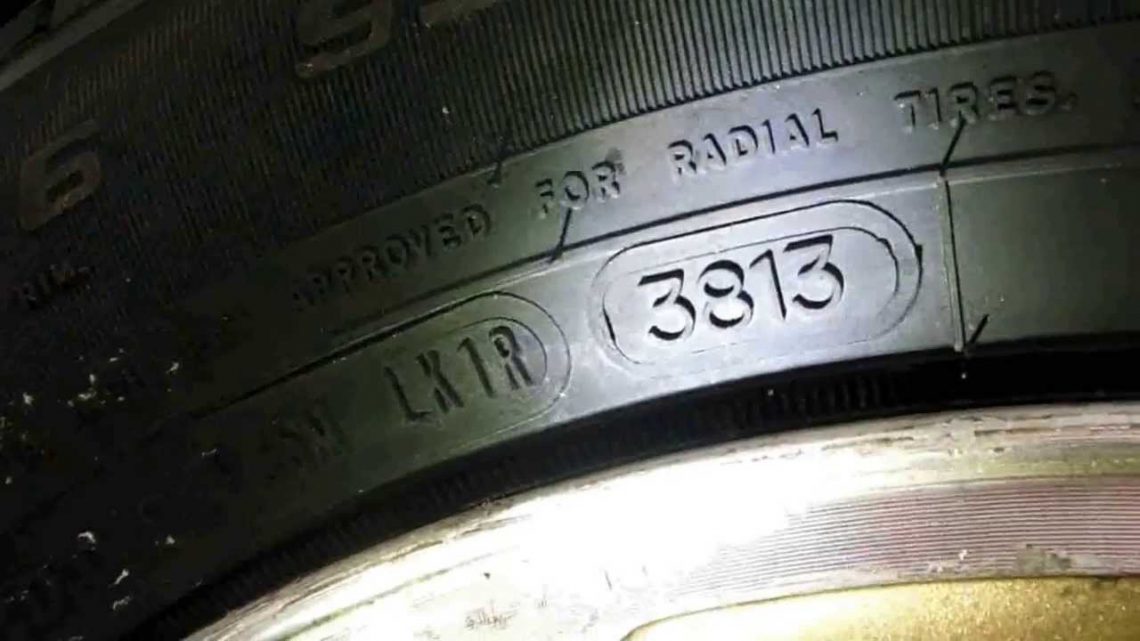
An in-depth look into fatal crashes related to vehicle tires by ABC News 20/20 In Touch — “Aging Tires That look New” (see http://abcnews.go.com/Video/playerIndex?id=4815359) has revealed a growing concern in the U.S. regarding tire stores selling tires as “new” even though the code stamped on the tire indicates it could be actually more than six or seven years old. Visually, these tires do look brand new, but a code stamped on the side wall indicates some were built in the 1990s.
Investigators are linking some vehicle crashes, a number of them fatal, to the use of these “older” tires. The vehicle owners bought them recently, believing they were purchasing a “new” tire. Even though the tire was built almost a decade ago, it could be sold as “new” simply because it had never been mounted on a rim and used.
In North America, there is no “Expiration Date” stamped onto new tires and they can sit around in a warehouse or tire store for years deteriorating from age with no visible indication. In Britain, the BRMA (British Rubber Manufacturers Association) “strongly recommends no tire should be used six years after it was made.” Some vehicle manufacturers such as Ford have lobbied the U.S. government to put a six-year expiry date on tires. The NHTSA has also acknowledged that tire age is a significant factor in safety.
In Britain, the BRMA (British Rubber Manufacturers Association) “strongly recommends no tire should be used six years after it was made.” Some vehicle manufacturers such as Ford have lobbied the U.S. government to put a six-year expiry date on tires. The NHTSA has also acknowledged that tire age is a significant factor in safety.
There is a code on the tire that can tell you what the date of manufacture was. It is a four digit number usually near the DOT stamp in an elongated oval that when deciphered will tell you the week and year of manufacture. For example, the code 3002 will tell you this tire was made in the 30th week of 2002. The number 0104 indicates a manufacture date of the first week of 2004. The tire in our photo has a code of 0407 and was built in the 4th week of 2007.
Your tires are a very important part of your vehicle safety. For your sake and that of your passengers, do a little research to be sure you are not compromising your safety when replacing your tires.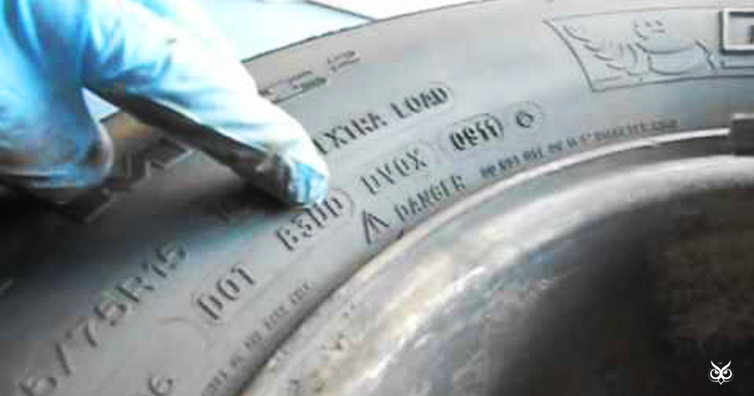
Follow Wheels.ca on
Facebook
Instagram #wheelsca
SHARE:
REPORT AN ERROR
JOURNALISTIC STANDARDS
ABOUT WHEELS.CA
Every year in the U.S., tire-related crashes cause 200 fatalities, according to the National Highway Traffic Safety Administration. Thankfully, it’s easy to monitor your tires, and how to tell if you need new tires, with a quick video and some basic information.
The primary functions of the tread on your tires are to grip the road and to divert water that causes hydroplaning. Tires with plenty of tread can help you maintain control and reduce your chances of getting a flat. With a quick monthly check of your tread and tire pressure, you’ll know if you need to replace your tires.
Tread wear bars are small, raised bits of rubber that run between the tread blocks. As these bars become even with the top of the tread, it is likely time for new tires. See more about tread wear bars below.
Tires will wear down over time, even if you don’t drive much. Sunlight, heat, and chemicals used to melt snow and ice can reduce rubber flexibility, causing tires to crack, lose air, and eventually fail.
There are many factors that may cause uneven wear, which could shorten the life of your tires. Vehicle alignment, tire pressure, lack of rotation, and/or worn steering and suspension components can all contribute to this problem. To prolong the life of your tires and reduce uneven wear, consider getting them rotated at consistent intervals. At Les Schwab, we recommend getting them rotated every 5,000 milles. The pros at Les Schwab will also conduct a free visual inspection of your steering and suspension components.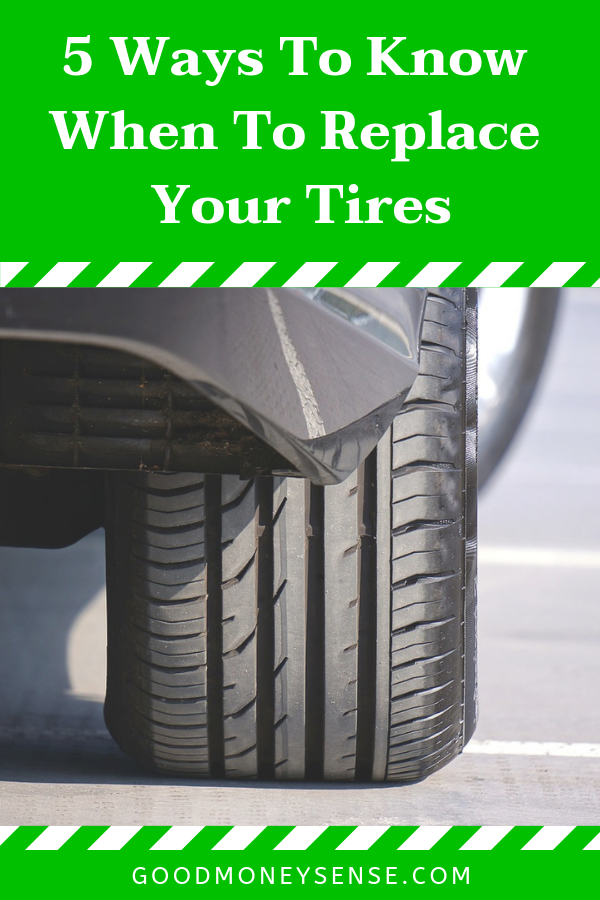 Schedule your free, pre-trip safety check today.
Schedule your free, pre-trip safety check today.
All tires deflate slowly over time, usually about 1 PSI (pounds per square inch) per month. Check yours monthly to keep them properly inflated. If your tires continually lose air or seem to completely deflate without warning, you may need to stop by Les Schwab for tire repair or replacement if necessary. Does the TPMS (Tire Pressure Monitoring System) light often appear on your dash? This could mean your tires have developed a slow, continuous leak.
If you hit a curb, pothole or other obstacle, your tires can develop sidewall bulges due to a break of the inner liner. These bulges can rupture causing a potentially unsafe situation. If you spot a bulge on your tires, get to your nearby Les Schwab and have your tires inspected.
If you experience new vibrations or thumping while driving, it could be a sign that one of your tire/wheel assemblies is out of balance. It could also indicate a suspension issue. Stop by your local Les Schwab and our professionals will check your tires, steering, and suspension.
It could also indicate a suspension issue. Stop by your local Les Schwab and our professionals will check your tires, steering, and suspension.
All tires sold in the United States today have what are called tread wear bars. The tread wear bars on your tires are there to help you see how much tread you still have. These wear bars are small, raised bars of rubber in the grooves of your tire. Look at the tread pattern and you’ll see these bars running between the tread blocks.
Look at the tread pattern and you’ll see these bars running between the tread blocks. As your tires wear, these bars will become increasingly flush with the tire’s tread. It’s important to replace your tires before this happens.
Depending on where and how you drive, and the conditions you face on the road, you might consider getting new tires before they reach that point. City driving in mild conditions may allow you to wait until the tread is closer to the tread wear bar before replacing your tires. More adverse conditions, such as rain, snow, and unpaved roads, may require you to replace your tires earlier.
City driving in mild conditions may allow you to wait until the tread is closer to the tread wear bar before replacing your tires. More adverse conditions, such as rain, snow, and unpaved roads, may require you to replace your tires earlier.
An easy way to check the tread on your tires is to do the penny test. Take a penny and place Lincoln’s head in one of the grooves of the tire tread. If you can see all of Lincoln’s head, it’s time to replace the tire.
If the penny goes in enough that the tire tread is at least as deep as Lincoln’s forehead, your tires are generally considered safe and do not need replacing. Check all four of your tires when conducting the penny test.
You’ll find your next set of tires at Les Schwab. You also find our world-class customer service at a tire shop near you that cares about your safety on the road.
SHOP TIRES
It's no secret that during operation a set of tires is subject to wear and over time it has to be replaced with a new one. But not many people know that tires can already have a tendency to accelerate wear at the acquisition stage. What is the reason for the short life of new wheels?
But not many people know that tires can already have a tendency to accelerate wear at the acquisition stage. What is the reason for the short life of new wheels?
What should I check when buying new tires?
Below are tips on what to look for and how to proceed when buying new tires. They are pretty simple.
1. Ask about storage conditions
Proper storage of tires in a warehouse is a guarantee of their long service life. If there is an opportunity to get to the warehouse, be sure to use it. Sometimes this can be done at the time of the final stage of issuing tires to the buyer.
If tires are stored:
Then, in this case, it is better to refuse to purchase them. The thing is that as a result of such storage, microcracks, deformation and damage may appear on the rubber. This is due to the loss of rubber elasticity and the wrong way to preserve tires. If the tires have the listed defects, then it will not last long. Maximum - one or two seasons.
This is due to the loss of rubber elasticity and the wrong way to preserve tires. If the tires have the listed defects, then it will not last long. Maximum - one or two seasons.
2. You need to look at the date of manufacture
If the wheels were produced more than three years ago at the time of their inspection, then you need to understand that the rubber composition of such tires has already lost some of its useful properties and has lost some of its elasticity. During subsequent operation, insufficient traction and destruction of rubber may be revealed. Although, theoretically, tires can be stored for five to eight years without losing their best qualities.
3. It is necessary to purchase wheels in the center where there is a tire service
In this case, when installing new wheels, hidden defects may be revealed and the seller will not be able to refuse to replace the damaged tire with a new one. In addition, a guarantee is usually given for the work of a tire fitting - within the allotted time, you can come and make a claim regarding the installation of tires.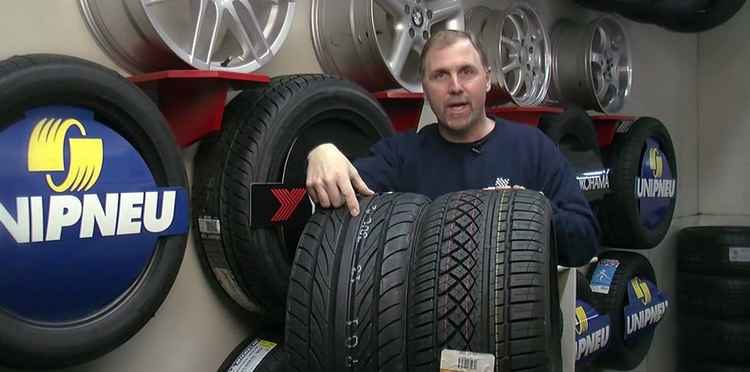
4. The seller must issue a check
Sometimes this is taken lightly and the check is thrown away. Under no circumstances should this be done. It is the presence of a check that will help to exchange defective tires for a new one.
5. Wash the tread with your fingers
The rubber should not be too soft. The fingers should not fall inward, but only slightly bend the tread - in this case, we can talk about good elasticity, and hence the retained grip properties.
6. Inspect the sidewalls of the tire
They should not have abrasions, let alone cracks/cut fragments. The sidewalls are the bearing part of the tire, and therefore any damage to them can cause an explosion / rupture of the wheel while driving, which is very dangerous.
Result: These simple recommendations can make it easier to choose tires and avoid buying defective ones. However, there is still no absolute panacea for low-quality rubber - the main defects are detected only during operation.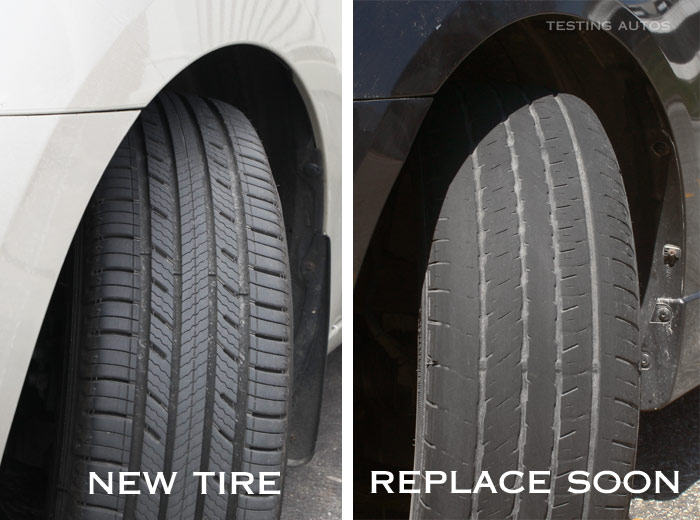
Contents
It's no secret that a set of tires wears out during operation and eventually has to be replaced with a new one.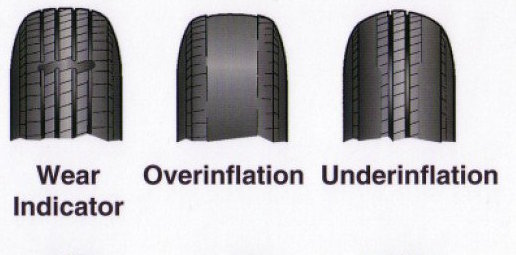 But not many people know that tires can already have a tendency to accelerate wear at the acquisition stage. What is the reason for the short life of new wheels?
But not many people know that tires can already have a tendency to accelerate wear at the acquisition stage. What is the reason for the short life of new wheels?
What should I check when buying new tires?
Below are tips on what to look for and how to proceed when buying new tires. They are pretty simple.
1. Ask about storage conditions
Proper storage of tires in a warehouse is a guarantee of their long service life. If there is an opportunity to get to the warehouse, be sure to use it. Sometimes this can be done at the time of the final stage of issuing tires to the buyer.
If tires are stored:
Then, in this case, it is better to refuse to purchase them. The thing is that as a result of such storage, microcracks, deformation and damage may appear on the rubber. This is due to the loss of rubber elasticity and the wrong way to preserve tires. If the tires have the listed defects, then it will not last long. Maximum - one or two seasons.
Maximum - one or two seasons.
2. You need to look at the date of manufacture
If the wheels were produced more than three years ago at the time of their review, then you need to understand that the rubber composition of such tires has already lost some of its useful properties and has lost some of its elasticity. During subsequent operation, insufficient traction and destruction of rubber may be revealed. Although, theoretically, tires can be stored for five to eight years without losing their best qualities.
3. It is necessary to purchase wheels in a center where there is a tire service
In this case, when installing new wheels, hidden defects may be revealed and the seller will not be able to refuse to replace the damaged tire with a new one. In addition, a guarantee is usually given for the work of a tire fitting - within the allotted time, you can come and make a claim regarding the installation of tires.
4. The seller must issue a check
The seller must issue a check
Sometimes this is taken lightly and the check is thrown away. Under no circumstances should this be done. It is the presence of a check that will help to exchange defective tires for a new one.
5. Wash the tread with your fingers
The rubber should not be too soft. The fingers should not fall inward, but only slightly bend the tread - in this case, we can talk about good elasticity, and hence the retained grip properties.
6. Inspect the sidewalls of the tire
They should not have abrasions, let alone cracks/cut fragments. The sidewalls are the bearing part of the tire, and therefore any damage to them can cause an explosion / rupture of the wheel while driving, which is very dangerous.
Result: These simple recommendations can make it easier to choose tires and avoid buying defective ones. However, there is still no absolute panacea for low-quality rubber - the main defects are detected only during operation.
Source
When buying tires, you need to carefully evaluate their quality, especially if you buy already used goods. If you choose an option in good condition, you can save money without compromising the reliability and safety of the car.
Tread depth determines how the wheels will contact the road. The higher the value of this parameter, the better the traction will be. In the rain, water will be removed from the contact patch faster, which will prevent the occurrence of hydroplaning.
The tread depth must be at least half of the tire's original condition for safe driving. That is, this indicator should not be less than 3-4 mm.
When buying, you need to take into account that during operation this parameter will change downwards. For winter wheels, it is better not to buy rubber with a tread depth of less than 4 mm. You can measure this parameter using a special probe with marks or a regular ruler.
In addition to the tread depth, you need to pay attention to the uniformity of rubber wear, since even if there is an allowable value of 3-4 mm, it is possible that wheel wear in different areas will be different.
If increased wear is observed on the outer side of the wheel, then this indicates the operation of the car with insufficient tire pressure. Such tires can cause problems with vehicle handling in the future.
If there is excessive wear in the middle part, then, on the contrary, this indicates that the wheels were overinflated and this led to increased wear in the contact patch area. Such wheels can make braking difficult, and this already significantly increases the risk of an accident.
Uneven wear can also occur due to wheel imbalance, problems with the vehicle's chassis or due to a specific driving style. If the wear is uneven, then it is better to refuse to purchase such tires, since their operation will make driving a car unsafe.
Sipes are the narrow grooves that can be seen in each tread block. It is the sipes that help the tread keep grip, which is ensured by the presence of special edges on the sipes. If the car is actively used, then these edges wear out over time, which worsens the control of the vehicle.
In addition, the braking distance depends on the condition of the edges. When driving on wet asphalt, traction deteriorates, which increases the risk of driving. When inspecting tires, the gripping edges can be checked by touch. If the teeth differ in sharpness, then this indicates damage and wear to the edges.
Good tread depth and no edge wear is no guarantee of tire quality. Rubber loses its original properties over time, even if it is not used for its intended purpose. Over the years, the material ages, molecular bonds deteriorate, it becomes less durable.
Therefore, even when buying new tires, you need to pay attention to the date of their manufacture, as often the product is stored in a warehouse for a long time, and this significantly worsens its performance.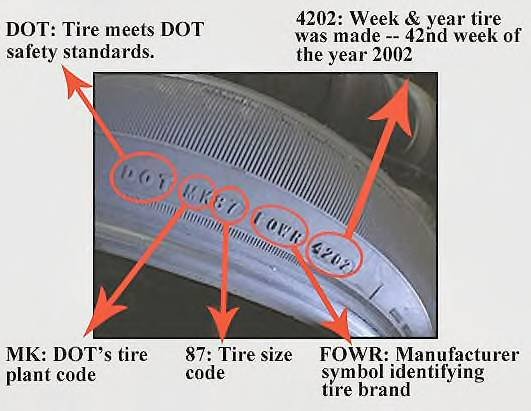
A car owner selling used tires may claim that they have hardly been used, have good tread depth and little wear. Do not rush to agree to the purchase, in this case you need to carefully inspect the product for damage and cracks. The rubber should be evenly colored, no seals or loose areas should be felt when probing.
Inspect tires in two steps.
The rubber is removed from the rim and the inner and outer surface is checked for signs of repair, patches, cuts and punctures.
After that, the wheel is assembled and the pressure in it is pumped to a level exceeding the recommendations for operating the car. Next, the wheel is balanced and checked for static imbalance.
For possible further use of rubber, at this stage no flaws, hernia and runout should be detected, otherwise it is better to refuse the purchase.
Defects that seem insignificant can significantly affect the safety of driving a vehicle. When buying used tires, you need to carefully check their condition, make sure that there are no external and hidden defects, and also pay attention to the date of their manufacture.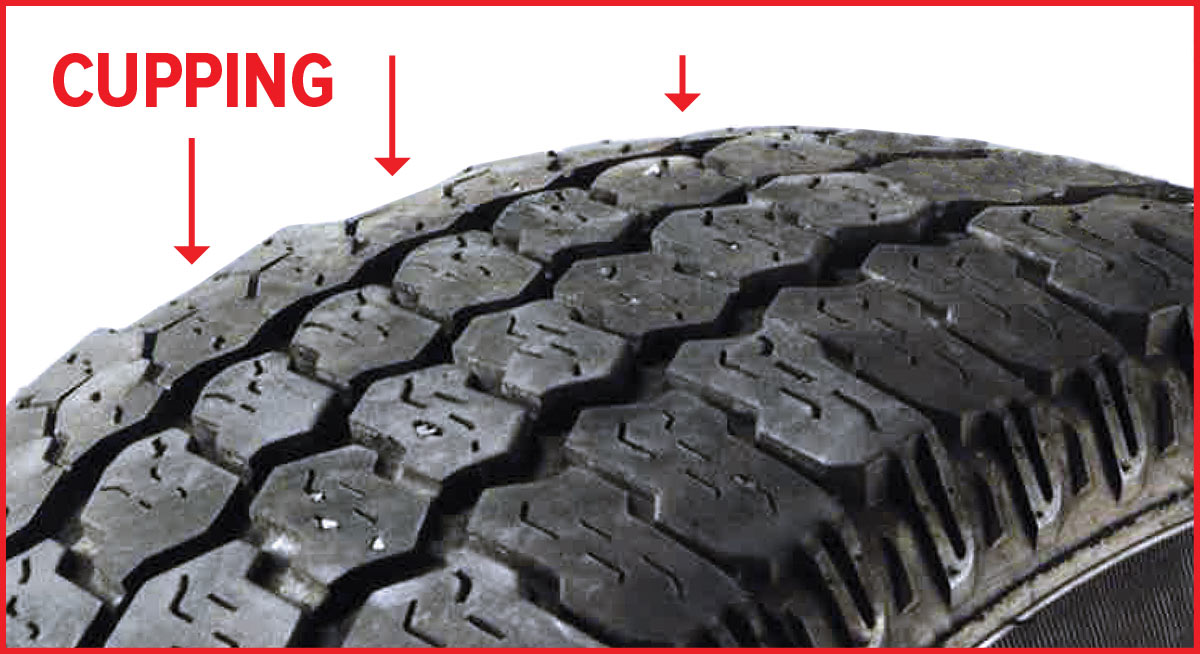 Even with minimal wear, after 4-5 years of operation or storage, rubber loses its properties.
Even with minimal wear, after 4-5 years of operation or storage, rubber loses its properties.
Source
A modern car is a true friend and helper, its performance depends on timely efficient maintenance, quality parts. Since the safety of a car also depends on the quality of tires, every motorist should know the main features by which you can identify the original product.
When choosing tires, it's best to focus on well-known brands from reputable sellers.
When buying rubber, it is recommended to check that the number on the side surface matches the number indicated in the certificate. These indexes must match exactly. All marks on the tire must be clear, even, located on the same level.
There can be no mesh of microcracks, joints, swellings on the sidewall. The tread pattern of a certain type of tire must match the description in the technical data sheet.
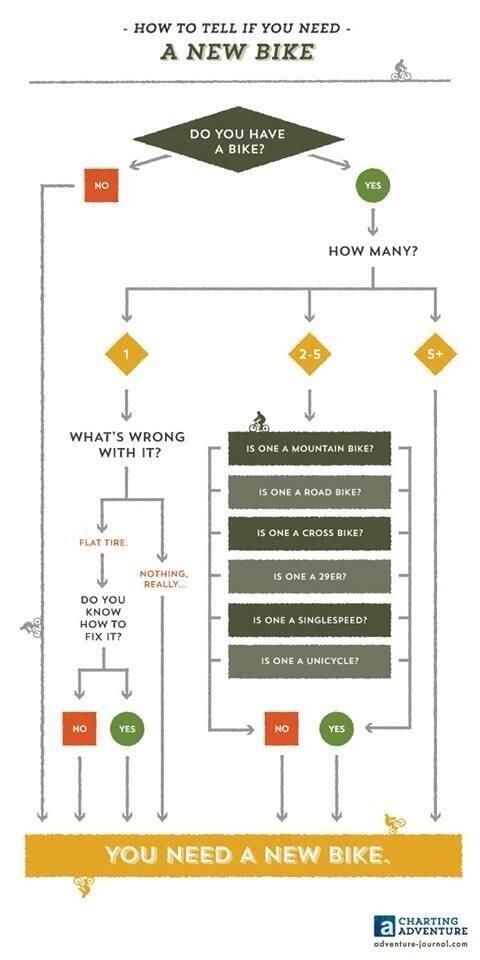
The tire sidewall contains a lot of information. Here on the original tires you can find information about the manufacturer, size, load index, speed, seasonality. It is important to check the date of manufacture, which is applied to the surface of the tire on the side in an encrypted form with four digits inside the oval rim after the quality indices.
The last two mean the year, and the first two mean the week. Car tires should be relatively fresh. If such a marking is missing or located elsewhere, contains incorrect information, then this often indicates a fake. Therefore, it is better to refuse the purchase of such products.
The quality of the original tires can also be seen from the edge against the rim. Here are the color marks that are important for balancing, and for European manufacturers they mean the following:
If there are no such color marks, then with a high degree of probability we can talk about a fake.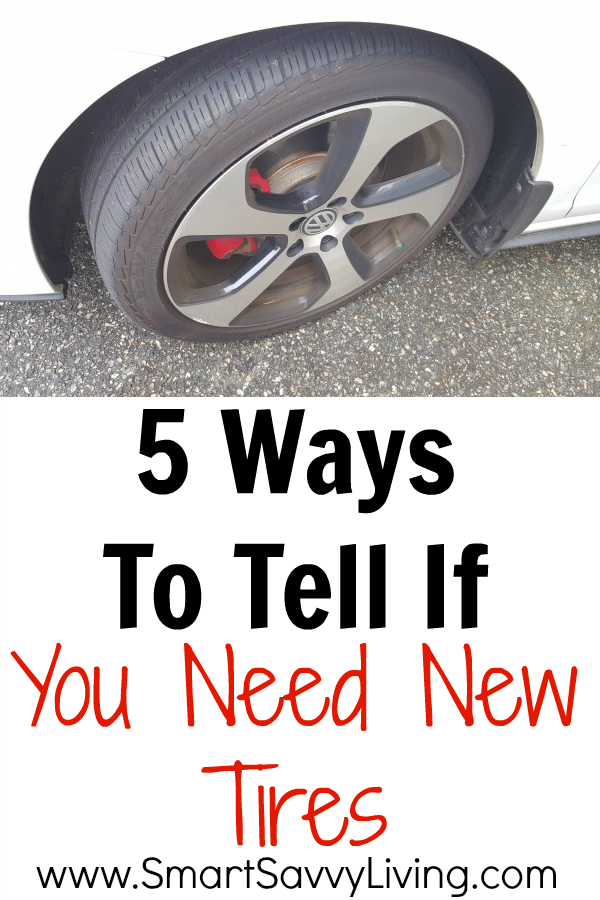
Counterfeit tires can be identified by their suspicious appearance. When buying, you should carefully examine them:
Leadership in the modern car tire market is held by several well-known manufacturing companies. Among them, the most popular are Goodyear, Yokohama, Michelin. Their products are designed in great detail, made from proven quality materials.
Fake rubber is often tried to pass off as products of well-known brands. At the same time, scammers often do not even bother to write the name correctly. It should be remembered that codes and designations are located on the side surface next to the company name.
For example, "E" stands for European quality standards and "DOT" stands for American quality standards. Next to such designations, the number of the certificate in encoded form is applied.
One of the most important indicators of rubber originality is stable internal pressure.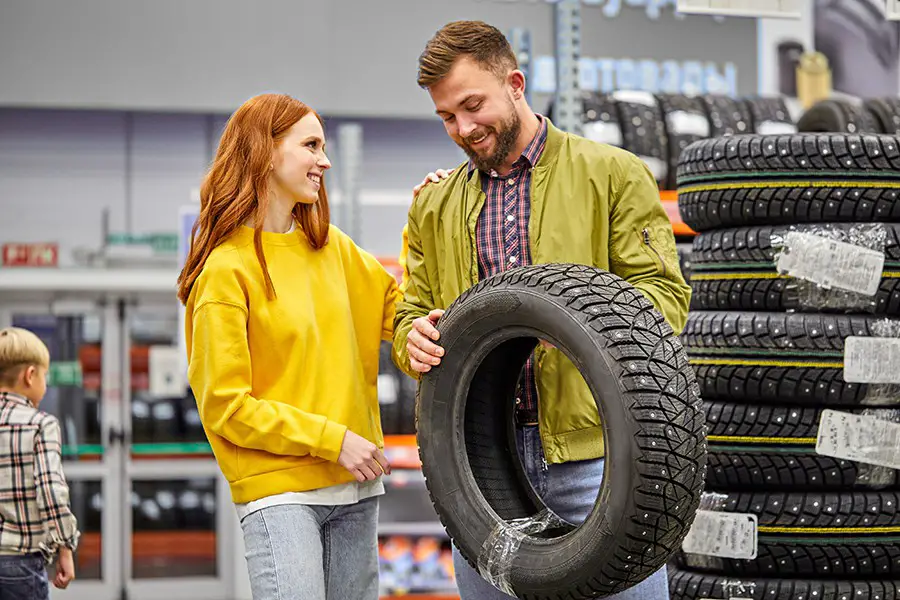
From the very beginning of operation, after inflation to a certain level, the tire pressure must be maintained for a long time. Its decrease may indicate delamination of the entire tire from the inside.
In most cases, this phenomenon is the result of improper storage of products under unsuitable conditions. Over time, this can lead to serious consequences.
Thus, when buying car tires, you need to exercise maximum care and attention, check the drawing and marking of the product with the documents.
Source
We have already written how to check the geometry of the body, generator, ignition system, battery, engine, chassis when inspecting a used car. In this article we will tell you how to check the tires when buying a used car.
Some experts say that using tires is like playing Russian roulette - you only have to rely on luck. And to make the case really happy, you should check the wheels as carefully as possible.
And to make the case really happy, you should check the wheels as carefully as possible.
Tires are a guarantee of safety on the road. When inspecting a car and used tires, check the following:
Each of the parameters is important in its own way, and therefore ignoring even one of them can significantly reduce the level of safety on the road.
We recommend checking first. If the tires have served their allotted time, further operation does not seem rational. This is easy to do - the date consists of two digits: the week number and year of issue, applied to the outside of the rubber. If, upon inspection of the machine, it is found that the numbers on each wheel are different, then this indicates a non-simultaneous replacement of the wheels. The reason for the replacement, if the service life has not yet come up, you should ask the seller.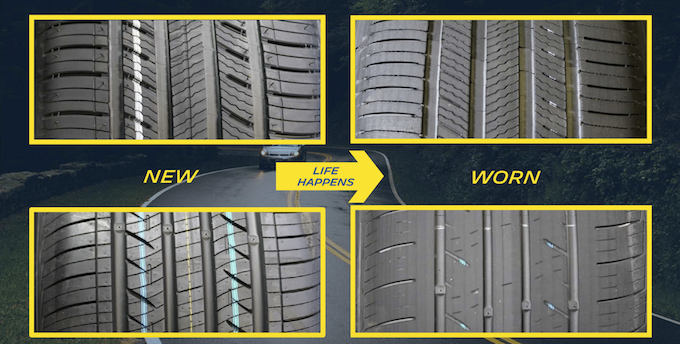
Visual inspection is sufficient to check tire wear. It is important that tire wear (if any) is uniform over the entire circumference of the wheel. Uneven tire wear can be a sign of wheel imbalance, and it also indicates a possible sloppy driving style of the previous owner, which can cause several more problems when operating a car. Increased wear on the outside indicates insufficient tire pressure, which should also be checked before a test drive. The operation of such wheels is fraught with the fact that in corners the rubber will not “hold” the road well. If the center part was more subject to wear, get ready for a decrease in acceleration, handling and braking.
When buying a car, be sure to pay attention to this parameter. Tests show that the permissible tread depth should be at least half of the original - for summer tires it is at least 3 mm (1.6 mm by law, but it would be better to leave a margin), for winter tires - at least 4 mm. It is not difficult to check the depth - in car dealerships you can buy a special probe with marks or use a simple ruler.
It is not difficult to check the depth - in car dealerships you can buy a special probe with marks or use a simple ruler.
When inspecting the tread, it is not superfluous to check for signs of repair from the inside (on a smooth surface). By themselves, the patches on the tread are not critical, but only if their number does not exceed a couple of pieces per wheel, and their size is a third of the width of the pattern. Otherwise, the operation of the "horse" on such wheels should be abandoned. Pay attention to the nature of the patch - the restored tread pattern (the so-called "grooving") can result in a tire rupture.
The tire grips the road surface across the entire tread width. The edges of the tire also have an impact on braking performance. The smaller they become, the less grip the rubber has on the road surface, and therefore the risk of driving on wet or slippery surfaces increases. A worn leading edge indicates problems with the car's suspension, which is also worth paying attention to. You can check this part of the tread "by touch" - the problem is present if the teeth on the tread edges differ in sharpness.
You can check this part of the tread "by touch" - the problem is present if the teeth on the tread edges differ in sharpness.
Tire micro cracks can occur even under conditions of minimal rubber wear and careful storage. The average service life of rubber is 5 years, but, as a rule, by the end of the term, the tire naturally becomes unusable. In the presence of small cracks, it is not recommended to exceed the speed of more than 80 kilometers per hour, otherwise the chances of complete tire wear increase rapidly. Deep cracks appear with a large degree of delamination of the tire. The use of such tires is highly discouraged.
Defects in the form of cuts and repair marks are a clear signal to stay away from the selected used rubber. As a rule, side cuts of the tire are dangerous due to the fact that the repair of such defects is extremely difficult and not gives a further guarantee of the quality of rubber operation.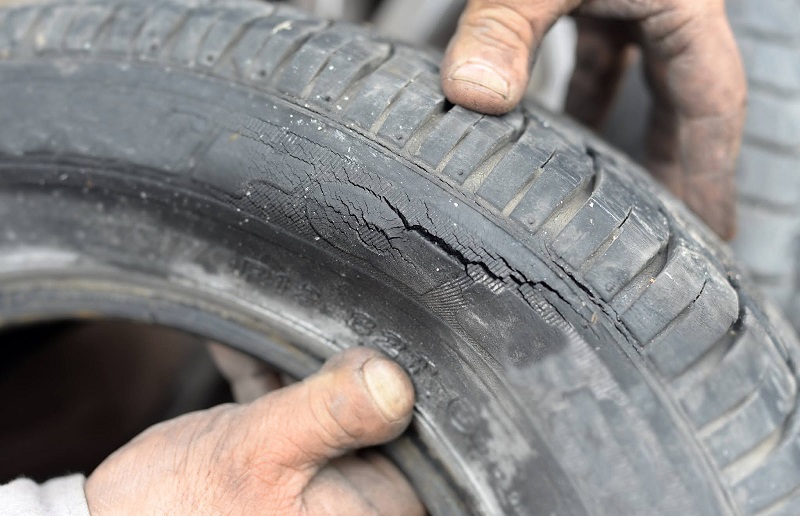 But, in addition, it is necessary to check and make sure that there are no hidden damages. Deformation of the tire carcass in the form of dents and creases can be the result of driving or parking on a flat tire, as well as a strong impact. The end of the service life in this case may come earlier than expected.
But, in addition, it is necessary to check and make sure that there are no hidden damages. Deformation of the tire carcass in the form of dents and creases can be the result of driving or parking on a flat tire, as well as a strong impact. The end of the service life in this case may come earlier than expected.
The internal delamination of the tire is extremely difficult to detect. A warning can be various types of swelling on the inside of the tire. Visible breaks in the layer are also possible. Check the degree of puncture of the tire - when pressed with two thumbs, the tire should not deform much, but will quickly return to its original shape.
These tire and wheel test parameters apply to both summer and winter tires. But, in the cold season, when the car is “reshod” in winter tires, some other factors should be taken into account.
In winter, buying a car with winter tires is considered correct, but another situation is possible, so do not neglect to inspect the wheels. First of all, you should check what the car is “shod” in - it can be idle for a long time, especially if the transaction takes place in the car market. Winter wheels are divided into two types: studded and friction.
First of all, you should check what the car is “shod” in - it can be idle for a long time, especially if the transaction takes place in the car market. Winter wheels are divided into two types: studded and friction.
Equally important is the tread depth. For 100%, it is customary to take the tread depth of new tires, 0% - unusable, respectively. The minimum permitted tread depth for winter tires is 4 mm, otherwise 0%. From the factory, tires are produced with different depths. Keep in mind that if the initial depth reached 8 mm, then 4 mm is not 50% wear, as some sellers say.
A buyer's vigilance will be a guarantee of a good deal. Bad tires in the general good condition of the car is not always a reason to refuse a purchase. If the wear is natural and even, and also corresponds to the average life of tires, the option of purchasing a car is worth considering. You can always eventually replace the rubber with one that will inspire confidence.
In order to avoid doubts about the history of the purchased car during the inspection, check the history of the car using the Autocode online service. To obtain a complete report, only the VIN, chassis number or state number of the vehicle of interest is required.
By driving in unique car numbers, you will receive the following data:
Tire wear or other negative factors may be hidden by the seller. So that they do not subsequently lead to problems in other parts of the machine, order an on-site Autocode check. The specialist will arrive at the place at any time and conduct a professional inspection of the vehicle. Checking the machine through Autocode will help to verify the correctness of your assumptions or refute them.
Source
Most motorists are well aware that during long-term use of the car, tires wear out and it is time to replace them. But not everyone knows that when purchasing new tires, you may encounter the fact that they will also undergo accelerated wear. What are the reasons for this? How to avoid accelerated wear and what to look for when buying a new pair of shoes for a car?
What are the reasons for this? How to avoid accelerated wear and what to look for when buying a new pair of shoes for a car?
All of these factors are detrimental to the integrity and reliability of tires. Because of them, the rubber begins to crack, deform and break. Even with one of these points, the quality and durability of rubber becomes a big question. Such a tire will last only 1-2 seasons and then it will be necessary to purchase new tires.
The date of manufacture of the tire is in an oval on the sidewall
Although the above tips and recommendations do not contain any complex or specific requirements, yet many drivers neglect them.